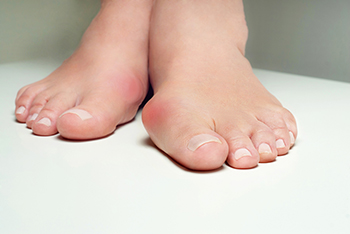Connect With Us
Blog
Items filtered by date: May 2025
Running with Plantar Fasciitis

Plantar fasciitis is a common cause of heel pain, especially in runners. It is caused by inflammation of the plantar fascia, the thick band of tissue that supports the arch of the foot. This condition often results from overuse, wearing improper footwear, tight calf muscles, or sudden increases in activity. Symptoms include sharp heel pain, especially with the first steps in the morning or after rest, and tenderness along the bottom of the foot. The heel may feel stiff, sore, or even swollen. Runners can reduce symptoms by wearing supportive running shoes with good arch support and cushioning, warming up properly, and doing regular calf and plantar fascia stretches. Cross-training with low-impact activities like swimming or cycling can help maintain fitness while reducing stress on the foot. A podiatrist can confirm the diagnosis and offer treatment, such as custom orthotics, targeted exercises, night splints, anti-inflammatory medications, and advanced therapies, if needed. If plantar fasciitis is affecting your running, it is suggested that you schedule an appointment with a podiatrist for appropriate treatment.
Plantar fasciitis can be very painful and inconvenient. If you are experiencing heel pain or symptoms of plantar fasciitis, contact Josef Elouze, DPM from Elite Podiatry. Our doctor can provide the care you need to keep you pain-free and on your feet.
What Is Plantar Fasciitis?
Plantar fasciitis is the inflammation of the thick band of tissue that runs along the bottom of your foot, known as the plantar fascia, and causes mild to severe heel pain.
What Causes Plantar Fasciitis?
- Excessive running
- Non-supportive shoes
- Overpronation
- Repeated stretching and tearing of the plantar fascia
How Can It Be Treated?
- Conservative measures – anti-inflammatories, ice packs, stretching exercises, physical therapy, orthotic devices
- Shockwave therapy – sound waves are sent to the affected area to facilitate healing and are usually used for chronic cases of plantar fasciitis
- Surgery – usually only used as a last resort when all else fails. The plantar fascia can be surgically detached from the heel
While very treatable, plantar fasciitis is definitely not something that should be ignored. Especially in severe cases, speaking to your doctor right away is highly recommended to avoid complications and severe heel pain. Your podiatrist can work with you to provide the appropriate treatment options tailored to your condition.
If you have any questions, please feel free to contact our office located in (Holiday City) Toms River, NJ . We offer the newest diagnostic and treatment technologies for all your foot care needs.
Keep Your Feet Healthy So You Can Stay Active
Ankle and Foot Injuries in Gymnasts

Ankle and foot injuries are common in gymnastics due to the intense physical demands of the sport. Gymnasts often perform high-impact skills that involve repeated jumping, tumbling, and landing, all of which place tremendous force on the lower extremities. These movements, when done multiple times a day, increase the risk of overuse injuries such as stress fractures and ligament strains. Young athletes are especially vulnerable as their growing bones and joints are more susceptible to injury. Improper landing techniques, such as uneven weight distribution or poor foot alignment, can also contribute to sudden injuries like sprains or fractures. The combination of impact, repetition, and technique makes the feet and ankles particularly prone to stress. If you have sustained a foot or ankle injury during a gymnastic routine, it is suggested that you promptly visit a podiatrist who can offer effective treatment solutions.
Sports related foot and ankle injuries require proper treatment before players can go back to their regular routines. For more information, contact Josef Elouze, DPM of Elite Podiatry. Our doctor can provide the care you need to keep you pain-free and on your feet.
Sports Related Foot and Ankle Injuries
Foot and ankle injuries are a common occurrence when it comes to athletes of any sport. While many athletes dismiss the initial aches and pains, the truth is that ignoring potential foot and ankle injuries can lead to serious problems. As athletes continue to place pressure and strain the area further, a mild injury can turn into something as serious as a rupture and may lead to a permanent disability. There are many factors that contribute to sports related foot and ankle injuries, which include failure to warm up properly, not providing support or wearing bad footwear. Common injuries and conditions athletes face, including:
- Plantar Fasciitis
- Achilles Tendinitis
- Achilles Tendon Rupture
- Ankle Sprains
Sports related injuries are commonly treated using the RICE method. This includes rest, applying ice to the injured area, compression and elevating the ankle. More serious sprains and injuries may require surgery, which could include arthroscopic and reconstructive surgery. Rehabilitation and therapy may also be required in order to get any recovering athlete to become fully functional again. Any unusual aches and pains an athlete sustains must be evaluated by a licensed, reputable medical professional.
If you have any questions please contact our office located in (Holiday City) Toms River, NJ . We offer the newest diagnostic and treatment technologies for all your foot and ankle needs.
How Edema Affects the Feet and Ankles

Edema is a condition characterized by the buildup of excess fluid in the body’s tissues, leading to swelling. When it affects the feet and ankles, it often causes them to appear puffy, feel tight, and sometimes become uncomfortable or tender to the touch. This swelling may worsen after long periods of standing or sitting and can make it difficult to wear shoes comfortably. Common causes include poor circulation, heart or kidney conditions, pregnancy, or certain medications. Edema may also result from injuries or inflammation, and the feet and ankles are especially vulnerable due to their position on the body and the effects of gravity. If your feet and ankles have become swollen, it is suggested that you consult a podiatrist who can determine what the cause is, and offer effective relief and treatment solutions.
Swollen feet can be a sign of an underlying condition. If you have any concerns, contact Josef Elouze, DPM of Elite Podiatry. Our doctor can provide the care you need to keep you pain-free and on your feet.
Swollen feet are a common ailment among pregnant women and people who stand or sit for extended periods. Aging may increase the possibility of swollen feet and patients who are obese often notice when their feet are swelling too. There may be medical reasons why swollen feet occur:
- Phlebitis - A condition that causes the veins to become inflamed and can also cause leg pain.
- Liver disease - This may lead to low blood levels of albumin which is a protein. This can cause fluid in the blood to pass into the tissues and several areas of the body can become swollen.
- Heart failure - When the heart doesn’t pump properly the blood that is normally pumped back to the heart can pool in the veins of the legs causing swollen feet.
- Kidney disease - One of the main functions of the kidneys is releasing excess fluid in the body. This type of condition can make it difficult for the kidneys to function properly, and as a result the feet may become swollen.
- Deep-vein thrombosis (DVT)- This is a serious condition where blood clots form in the veins of the legs. They can block the return of blood from the legs to the heart which may cause the feet to swell. It is important to be treated by a podiatrist if this condition is present.
Swollen feet can also be caused by bone and tendon conditions, including fractures, arthritis, and tendinitis. Additionally, there may be skin and toenail conditions and an infection may cause the feet to swell. Patients who take medicine to treat high blood pressure may be prone to getting swollen feet.
Many patients elevate their feet to help relieve the swelling and this is generally a temporary remedy. When a podiatrist is consulted the reason behind the swelling can be uncovered and subsequently treated.
If you have any questions please contact our office located in (Holiday City) Toms River, NJ . We offer the newest diagnostic and treatment technologies for all your foot and ankle needs.
When a Bunion Tells a Bigger Story

A bunion is more than a bump. It often signals how our feet adapt to years of pressure, imbalance, or genetics. This bony change at the base of the big toe can slowly alter the way we walk, affecting posture and even knee or hip alignment. While tight shoes and high heels are often blamed, bunions can form even in sensible footwear if foot mechanics are off. Pain, redness, or difficulty finding comfortable shoes are common complaints. Early care might involve custom inserts, padding, and toe spacers to ease pressure. In advanced cases, surgical realignment may offer lasting relief. Rather than waiting until the pain interferes with daily life, addressing a bunion early can help prevent further complications. If your big toe is drifting or causing discomfort, it is suggested that you see a podiatrist for appropriate treatment.
If you are suffering from bunions, contact Josef Elouze, DPM of Elite Podiatry. Our doctor can provide the care you need to keep you pain-free and on your feet.
What Is a Bunion?
A bunion is formed of swollen tissue or an enlargement of boney growth, usually located at the base joint of the toe that connects to the foot. The swelling occurs due to the bones in the big toe shifting inward, which impacts the other toes of the foot. This causes the area around the base of the big toe to become inflamed and painful.
Why Do Bunions Form?
Genetics – Susceptibility to bunions are often hereditary
Stress on the feet – Poorly fitted and uncomfortable footwear that places stress on feet, such as heels, can worsen existing bunions
How Are Bunions Diagnosed?
Doctors often perform two tests – blood tests and x-rays – when trying to diagnose bunions, especially in the early stages of development. Blood tests help determine if the foot pain is being caused by something else, such as arthritis, while x-rays provide a clear picture of your bone structure to your doctor.
How Are Bunions Treated?
- Refrain from wearing heels or similar shoes that cause discomfort
- Select wider shoes that can provide more comfort and reduce pain
- Anti-inflammatory and pain management drugs
- Orthotics or foot inserts
- Surgery
If you have any questions, please feel free to contact our office located in (Holiday City) Toms River, NJ . We offer the newest diagnostic and treatment technologies for all your foot care needs.


